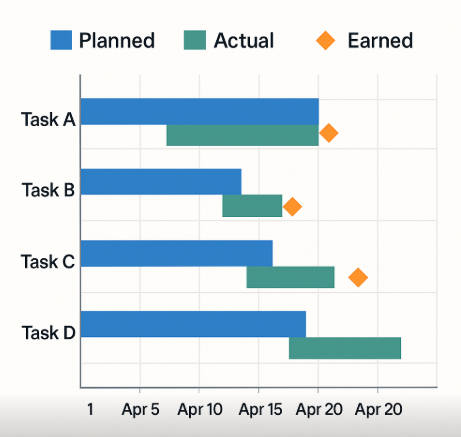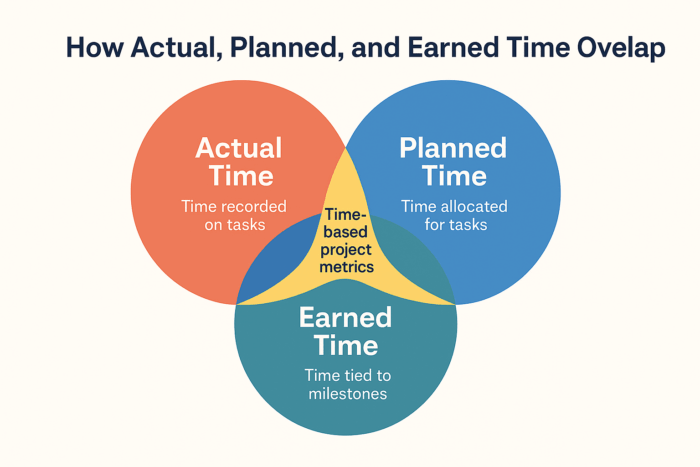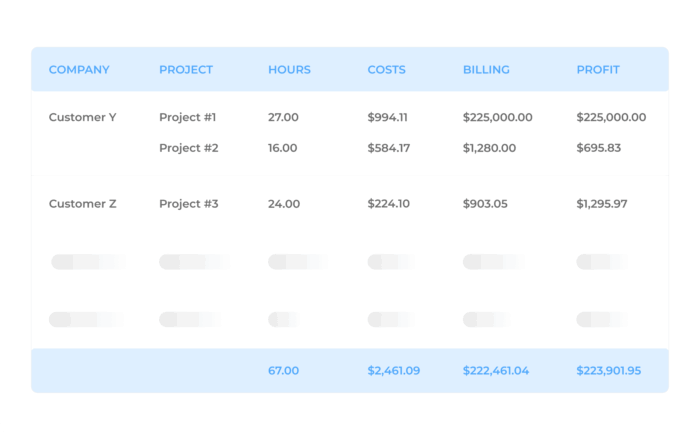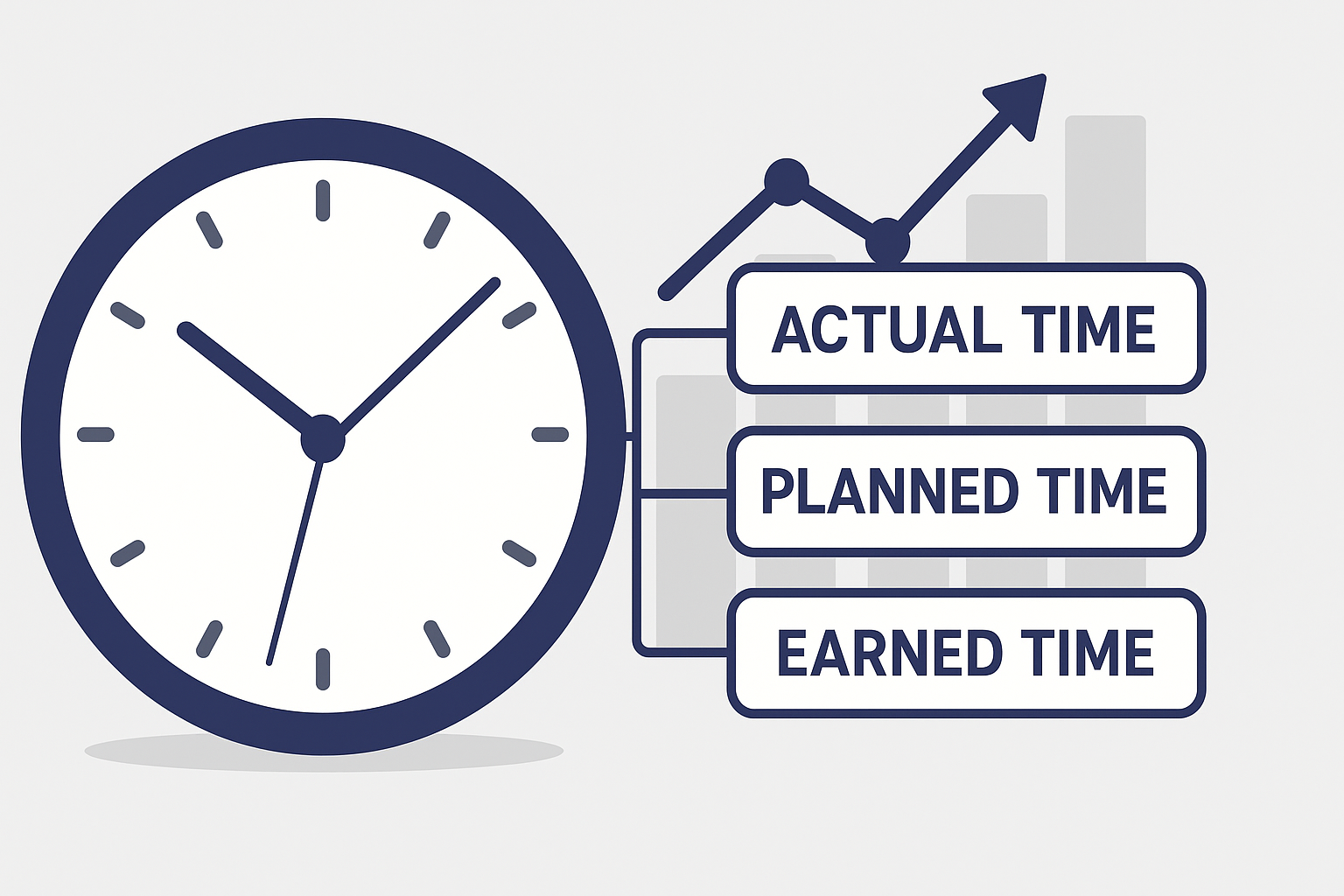Table of Contents
Table of Contents
In project time tracking, it’s crucial to understand the difference between actual time, planned time, and earned time. Think of these three metrics as lanes in a swimming pool — each moving you forward, but at a different pace and with a different story to tell about your project’s progress. On their own, they can feel disconnected. But when you bring them together through a smart project time tracking approach, they provide a full picture of your project’s health, efficiency, and direction.
In this article, we’ll break down what actual, planned, and earned time really mean, when to use each, and how they fit together in project management. We’ll look at real-world examples, common pitfalls, and best practices, plus explore today’s best tools — from flexible trackers to planning platforms and BI dashboards — that help managers balance these three critical metrics. By the end, you’ll see how mastering actual, planned, and earned time is less about logging hours and more about steering projects to success without drifting off course.
TL:DR: Everything you’ll learn from this article
✅ The real difference between actual time, planned time, and earned time
✅ How to use each metric effectively in project time tracking
✅ Practical, real-world examples across industries
✅ The biggest pitfalls (and how to avoid them) when tracking actual, planned, and earned time
✅ Today’s best practices and tools — from flexible time trackers to planning platforms and BI dashboards
What’s the difference between actual time, planned time, and earned time?
Planned time: The hours actually worked and recorded on a task or project.
Actual time: The estimated time scheduled for completing a task or project.
Earned time: The time value of work completed based on project progress.
Here’s a handy table with what each metric measures, when to use it, and its common challenges.
| Time metric | What it measures | When to use it | Common challenges |
| Planned time | Estimated time for task/project | Resource planning, budgeting | Scope changes, poor estimates |
| Actual time | Time actually worked and logged | Productivity analysis, payroll | Incomplete or late tracking |
| Earned time | Time value of work completed (progress) | Stakeholder reports, EVM, forecasting | Ambiguous milestones, rework |
As you can see, each metric tells a different story about your project’s health, efficiency, and direction. This article breaks down what each time metric means, how they relate, and why understanding all three is essential for better planning, decision-making, and performance evaluation. At the end we also shout out the top tools for handling actual, planned, and earned time, as well as today’s best practices.
Why is project time tracking the key to balancing actual, planned, and earned time?
During my professional career (more extended than I would like to admit), first as an HR IT consultant and then helping clients manage their time better for all types of businesses, I’ve come to realize that accurate project time tracking is key to bringing all sorts of projects to a successful completion. As I heard somewhere, “Money comes and goes, but time only drives in one direction, and that is further away. Always.”
From customers and on time, I’ve seen the whole spectrum of outcomes.
Tracking time enables you to not only better estimate similar tasks in the future, but also to identify over- or under-utilized members, bottlenecks and workload distribution. In other words, time tracking is KEY to project management success.
However, project managers often rely on time tracking but may overlook the crucial differences between actual time, planned time, and earned time.
How do time, cost, and performance shape project management success?
Let’s look at a few key concepts that go in hand with measuring time according to the PMBOK® Guide (Project Management Body of Knowledge), which was published by the Project Management Institute (PMI) and serves as a fundamental resource for project management principles and practices.
What is project time management?
Project time management involves the processes required to ensure timely completion of a project. It includes defining activities, estimating their duration, sequencing tasks, and developing and controlling the project schedule. The goal is to track planned vs. actual progress to meet deadlines efficiently. Techniques like the Critical Path Method and schedule compression are commonly used.
What is project cost management?
Project cost management focuses on planning, estimating, budgeting, financing, and controlling costs so that the project can be completed within the approved budget. It involves developing a cost baseline and tracking actual spending against it. Effective cost management helps identify variances and supports informed decision-making to keep the project financially on track.
What is project performance management?
Project performance management integrates scope, time, and cost data to assess how well the project is progressing. It relies heavily on Earned Value Management (EVM) to measure performance and forecast future trends. This approach enables project managers to evaluate both efficiency and effectiveness, guiding timely corrective actions when needed.
Breaking down actual time, planned time, and earned time
Actual, planned, and earned time are key concepts that project managers need to deeply understand to get the most out of. Let’s have a look at what they are exactly and how they tie into project management.
What is actual time?
Actual time is the number of hours actually worked and recorded on a specific task or project. Its main purpose is to provide accurate data on how time is truly being spent, helping project managers understand effort, productivity, and resource use.
When is actual time most useful to project managers?
Actual time is especially useful when evaluating team performance, identifying bottlenecks or inefficiencies, and ensuring accurate payroll and client billing. It also helps improve future estimates by comparing planned vs. actual work and supports more informed decision-making throughout the project lifecycle. Actual time is most valuable when you want to understand how work is really being done day-to-day. It provides hard data on how much time team members are spending on specific tasks, helping to identify potential issues. Over time, analyzing actual time helps teams refine processes, improve focus, and boost their output.
What is planned time?
Planned time is the estimated number of hours scheduled to complete a task or project. Its purpose is to serve as a baseline for project planning, helping managers allocate resources, set realistic timelines, and forecast workloads.
When is planned time most useful to project managers?
Planned time is particularly useful during the initial project planning phase to map out schedules and staffing needs, when creating budgets tied to time estimates, and when tracking progress by comparing estimated vs. actual performance. By estimating how long tasks should take, teams can schedule workloads, assign the right people to the right tasks, and forecast availability. When done accurately, planned time becomes a cornerstone for creating realistic timelines and avoiding burnout or idle time.
What is earned time?
Earned time is the time value of work completed, calculated based on project progress rather than hours worked. Its purpose is to measure how much of the planned work has actually been accomplished, providing a clearer picture of project performance and efficiency.
When is earned time most useful to project managers?
Project managers can use earned time when reporting progress to stakeholders, as it ties effort to results. Unlike raw hours logged, it reflects the actual value of the work completed relative to the plan, offering a more accurate view of whether a project is truly on track. This makes it a powerful metric for performance reporting, forecasting, and justifying budget or timeline changes. They can also use it during earned value management (EVM) to assess whether a project is on track, as well as when forecasting timelines and budgets by comparing planned, actual, and earned progress.
These time metrics also align with principles from the PMBOK® Guide, where they are used in EVM to assess project performance and forecast completion. Understanding how these fit into a larger project control framework enhances their strategic value.
You might be wondering why there are three different metrics for measuring time and if they really matter. Well, the answer is yes, they’re important! These metrics are relevant from different perspectives.

- Understanding earned value allows for the readjustment of project planning to better reflect actual progress, while simultaneously enabling the alignment of planned budgets with actual spending based on resource utilization.
- Taking a look at planned time vs. actual time can help improve future project planning accuracy and resource allocation.
- Finally, by tracking actual time, you allow for early identification of inefficiencies and can boost proactive communication
How do planned, actual, and earned time fit together?
Planned time is relatively straightforward to define and it always looks perfect on paper. Doing so accurately requires skill and most importantly, experience. There is no mystery about actual time; just make sure the employees track their time periodically and as rigorously as possible.
The difficult piece of the puzzle to match is always the earned part: How do you estimate how much time is left to complete a task? The time you already spent on it can serve as a reference, but a deceiving one. You might have spent 80% of the time you planned for a task, only to realize that the base concept was wrong and you need to start all over again. Earned time would be 0, while actual is close to 100% of what you planned.

This is like investing in the stock market: your decision to sell should be based on whether the stock you are analyzing will go up or down from the current moment, not the price at which you bought your shares, even if the right decision is to sell at a loss. Similarly, calculating earned time should always be based on actual work remaining, regardless how much time you already spent and how much time you originally planned. The latter can (and should) provide clues to estimate the work remaining though.
What does planned vs. actual vs. earned time look like in practice?
Example 1: Software development
Task: Implement user authentication module
| Metric | Description | Example |
| Planned time | The initial estimate for implementing the module. | 20 hours |
| Actual time | The time actually spent by the developer to complete the module. | 25 hours |
| Earned time | The value of work completed based on the project’s progress and milestones. | 18 hours (if only 90% of the module is done according to completion metrics) |
Sports Information Services (SIS) manages dozens of fast-paced software development projects and struggled with budget visibility, staff availability, and tracking actual vs. planned time. By implementing Beebole’s flexible timesheets, real-time cost insights, and quick search features, they gained the visibility needed to:
🚀 Track project costs and staff availability in real time
🚀 Set more accurate budgets and forecasts
🚀 Streamline their time tracking process
🚀 Make smarter resource allocation decisions
“Being responsible for a number of engineers and multiple work streams, Beebole makes my life easier by providing easy-to-access insights on costs and budgets, current work, staff availability, and holiday and absence tracking.”
Example 2: Content creation
Task: Write a blog post
| Metric | Description | Example |
| Planned time | The time allocated for researching, writing, and editing the blog post. | 8 hours |
| Actual time | The time it took to complete all steps of writing the blog post. | 7 hours |
| Earned time | The value of the completed blog post based on its contribution to goals. | 8 hours (if the blog post meets all quality and scope criteria) |
Example 3: Event planning
Task: Arrange venue decorations
| Metric | Description | Example |
| Planned time | The estimated time needed to set up all decorations at the venue. | 5 hours |
| Actual time | The time actually spent by the team to complete the venue decorations. | 6 hours |
| Earned time | The value of completed decorations based on milestones (e.g., stage setup). | 4 hours (if only 80% of decorations were completed as per defined milestones) |
Why is it difficult to manage actual, planned, and earned time?
What are the main challenges with actual time?
There is a significant risk of inaccuracies if not recorded promptly or consistently. Employees often consider time tracking a burden more than a tool at their disposal.
The risks associated with those challenges can be easily reduced by implementing the right time tracking solution that makes time tracking as easy as possible.
What are the main challenges with planned time?
Scope changes and resource availability are commonly the most relevant, even for seasoned project managers. Newer processes or/and processes without proper historical data can be easily overestimated or underestimated.
Personnel with the right experience, as well as access to historical data for similar processes can minimize those risks.
What are the main challenges with earned time?
Similarly to planned time, scope definition and clear deliverables and milestones are required to properly calculate Earned time. If the defined deliverables change after the initial planning, recalculating earned time becomes necessary and can increase in complexity depending on the extent of the changes.
Communication is key. Team members need to understand milestones to determine when a task is considered complete. The right tool to allow them to mark their tasks as completed will help. If that tool can automate task assignment, time tracking and communication will be even better.
What are the best tools to track actual, planned, and earned time?
To effectively implement and benefit from actual, planned, and earned time tracking, project team managers should use appropriate tools while also consistently following best practices. Here’s a list of some of the best top tools project managers might want to consider using today.
1. Beebole: Beebole is a flexible time tracking and reporting tool designed to help project managers monitor actual time spent across tasks, teams, and clients. With customizable dashboards and robust reporting features, PMs can compare planned vs. actual hours and generate insights to support earned value analysis. It integrates easily with spreadsheets and external systems for broader project performance monitoring. Don’t forget that Beebole offers plenty of integrations and can sync up with almost any other project management-aligned tools.

2. Smartsheet: Smartsheet offers collaborative work management with strong scheduling and resource planning features. Project managers can build detailed Gantt charts for planned time, track task progress in real time, and connect time data to high-level dashboards. It complements time tracking tools like Beebole by centralizing plans and dependencies.
- Would you like an alternative to Smartsheet? GanttPRO is more affordable, especially for smaller teams, and it’s got a simple learning curve with fast onboarding. Also notable are the dedicated features for planned vs. actual timeline comparisons and baseline tracking.
3. Microsoft Project: Microsoft Project is a powerful scheduling and planning platform that helps PMs define project timelines, assign durations, and baseline plans. It supports earned value management out of the box, letting teams compare planned vs. actual progress and calculate metrics like SPI and CPI. Beebole users can pair actual time data with MS Project schedules for deeper analysis.
- Would you like an alternative to Microsoft Project? ProjectLibre is a powerful open-source alternative to MS Project with support for WBS (work breakdown structure), Gantt charts, resource allocation, and critical path analysis. Depending on what you need it for, it might even be free. ProjectLibre also integrates well into legacy environments for teams that still rely on desktop project tools.
4. Asana: Asana excels at task and project coordination, making it easy to plan and visualize project timelines with its Timeline view. While it doesn’t focus on granular time tracking, it helps PMs define planned time and monitor task completion rates. When paired with a time tracking tool like Beebole, it creates a full picture of actual vs. planned progress.
- Looking for an Asana alternative? Nifty is a collaborative project management tool with milestones, task dependencies, and timelines, offering a more affordable, all-in-one task management workspace. A bonus is that it integrates easily with external time trackers.
5. PowerBI: Power BI is a business analytics platform that enables PMs to create custom dashboards and visualizations. By connecting data from Beebole and other project tools, managers can build real-time reports that track actual time, measure earned value, and forecast project performance. It’s ideal for presenting project health to stakeholders.
- Want a Power BI alternative? Metabase is a business intelligence tool that supports dashboards, visualizations, and SQL-based queries similar to Power BI. Metabase is open-source and free for many use cases, and it’s easy to set up, even for the most non-technical of users. If you’d like to avoid heavy licensing costs but still want to embed analytics into your daily operations, it’s a viable option.
6. Wrike: Wrike provides project planning, resource allocation, and real-time collaboration features. Its workload views and project timelines support planned time management, while built-in reporting tools help assess project progress. Beebole can supply the actual time data needed to enrich Wrike’s planning and performance metrics.
- Interested in a Wrike alternative? TeamGantt offers project planning, dependencies, and workload management similar to Wrike. Not only is it user-friendly with a focus on Gantt-style planning, but the drag-and-drop scheduling and tracking of actual vs. planned timelines is a nice touch. It also works well for visualizing planned vs. actual timelines over longer durations.
What are the best practices for managing actual, planned, and earned time?
Working with and understanding actual, planned, and earned time comes with its unique set of challenges, so we’ve compiled tips for how to get the most out of all three based on our experience at Beebole. Below you’ll see we’ve divided them into core implementation practices and advanced strategies.
Core implementation practices for handling actual, planned, and earned time
1. Establish consistent time tracking standards
It might be easy to forget this step, but it’s actually key. Standardize how actual time is captured across all team members and projects. This includes defining what activities should be tracked, how granular the tracking should be, and which tools or methods to use. If you want to be able to make meaningful comparisons between actual, planned, and earned time, consistency in data collection is a must.
2. Implement dynamic planning processes
Don’t fall into the trap of trying to set it and forget it with planned time. Instead, treat planned time as a living baseline rather than a fixed commitment. Schedule regular reviews to reassess and adjust time estimates as project scope, requirements, or constraints evolve. This practice prevents teams from being anchored to unrealistic initial estimates and improves future planning accuracy.
3. Define clear, measurable completion criteria
Establish specific, unambiguous definitions for what constitutes task completion when calculating earned time. Try as best as you can to remove the guesswork from this by creating detailed acceptance criteria for each milestone or deliverable. This way, progress measurement remains objective and consistent across team members.
4. Provide training
Educate all stakeholders on the purpose, methodology, and business impact of each time metric. When team members understand how their time tracking data influences project decisions and organizational learning, they’re more likely to provide accurate, timely information.
5. Mix and match with the right project management platforms
When putting together your project management stack, make sure you find tools that cover your needs and integrate together, making sure to cover scheduling, budgeting, resource allocation, and time tracking. Integration eliminates data silos and enables real-time alignment between planned schedules, actual progress, and earned value calculations.
6. Set regular review cycles
By having weekly or bi-weekly sessions to analyze time variance between actual, planned, and earned time, you’ll be more likely to identify patterns, address bottlenecks early, and make data-driven adjustments to project execution strategies.
7. Create variance thresholds and alert systems
Deviations are bound to happen in project management, but to a point. Set acceptable tolerance levels for deviations between time metrics and configure automated alerts when variances exceed these thresholds. This type of proactive monitoring can help you intervene before small issues become major problems.
8. Maintain historical data for trend analysis
Preserve time tracking data across multiple projects to identify long-term patterns in estimation accuracy, team productivity, and project complexity factors. A historical perspective can improve future planning and resource allocation decisions.
9. Implement role-based tracking granularity
Adjust the level of detail in time tracking based on team roles and project phases. Senior stakeholders may need high-level summaries, while project managers require detailed breakdowns, and individual contributors need task-specific guidance.
10. Foster a learning-oriented culture
Frame time tracking as a tool for continuous improvement rather than performance monitoring. Encourage honest reporting by emphasizing that accurate data helps the entire team learn and improve, regardless of whether actual time exceeds estimates.
The takeaway: Why these three time metrics matter
Understanding the differences between planned, actual, and earned time is not just an exercise—it’s a foundational practice in effective project management. These three metrics offer complementary perspectives that, when used together, allow you to track progress realistically, adjust course proactively, and improve planning accuracy over time. No matter what your company or team size is or what tasks and projects you have at hand, getting a grip on these time concepts will lead to better outcomes, more accurate forecasts, and stronger team performance.


